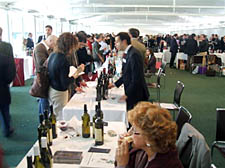|
|
 |
| |

Members of the public enjoying samples at Lord’s |
Portuguese wine is coming of age
Trade fair turns into a public affair at Lord’s
AT Lord’s, the home of Middlesex Cricket Club, 100 Portuguese wine producers and importers gathered for Wines of Portugal, an extremely well-organised trade event with a difference.
Members of the wine-imbibing public – usually proscribed from these trade affairs – were also invited to last week’s event.
In what some might consider the headquarters of English elitism, wine, generally regarded as a snobbish drink, tentatively tipped its cap in the direction of egalitarianism and consumer empowerment.
The Portuguese wine industry is making a splash in the UK wine press. Recently, Harpers, a weekly magazine for the drinks trade, featured the country. The three-page article was followed by a full-page ad for Tagus Creek, billed as “The Portuguese wine brand that everyone is talking about”.
Available in most major supermarkets, this is an anglicised wine, totally unknown in Portugal – and devised by an English importer – which features the superstars of the wine world, Shiraz and Chardonnay, blended with some local Portuguese grapes.
Fortunately, although Tagus Creek and other similar outfits were represented at Lord’s, many of the exhibitors have a different philosophy; indigenous grapes, a local identity and (mostly) native producers were the order of the day.
This new generation of Portuguese wines is made exclusively from traditional grapes. Using modern production methods, the natural high acidity is controlled and the tough tannins tamed.
Traditionally, Portuguese wines can take years to mature. These new wines mature early and offer a range of tastes which, although different, encompass a link to the kind of wines we all know and usually buy.
Last week at Lord’s, hundreds of these new “traditional” wines from across Portugal’s multifarious wine regions were made accessible to the cream of the wine business – the people who buy and drink the stuff.
For wine buffs looking for the finest and wanting to taste the difference, there was a lot on offer. Very good wines, some costing upwards of £30 per bottle including Dao, a red, and Vinho Verde, a young, often low in alcohol white.
But what made this day special was the arrival in the early evening of the wine drinking public.
A handful of buyers from the big supermarkets dominate the UK wine industry.
For years they have stood between producers and shoppers and created an industry where only international brands and big corporations – producing wines that try to be all things to all people – can hope to prosper.
But the past few years have seen the continuing development of a genuine tripartite relationship between food producers, small retailers and shoppers.
Wine, perhaps because most is produced abroad, has lagged behind. But after years of decline, independent wine shops are opening and new outlets are being developed.
Most of the new generation of food shops and international delis sell wine. Hopefully, more winemakers and their agents will open their trade events to the public.
It’s been a long hard winter in the world of wine, but the first buds of a new spring are beginning to blossom.
|
 |
|
|
 |

|
|
 |
|









